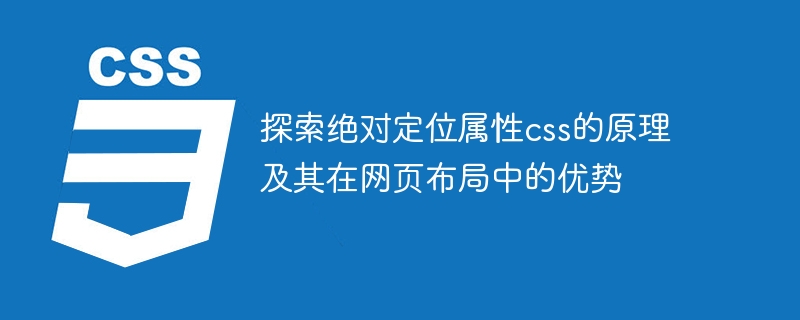

Explore the principles of absolute positioning attribute CSS and its advantages in web page layout
Positioning elements is a very important concept in web design and development. Among them, absolute positioning is a commonly used positioning method, which allows us to more precisely control the position and layout of elements on the page. This article will explore the principles of absolute positioning CSS and introduce its advantages in web page layout. Some concrete code examples will also be provided.
First, let’s understand the principle of absolute positioning. Absolute positioning is positioned relative to the nearest positioned (non-static) parent element, or, if there is no positioned parent element, relative to the original containing block (usually the body) that exists. By setting the top, right, bottom and left attributes, we can determine the specific position of the element on the page. Additionally, absolutely positioned elements fall out of the document flow and do not affect the position of other elements.
Absolute positioning has the following advantages in web page layout:
Next, let’s look at some specific code examples.
<!DOCTYPE html>
<html>
<head>
<style>
.container {
position: relative;
width: 500px;
height: 300px;
border: 1px solid black;
}
.box {
position: absolute;
top: 50%;
left: 50%;
transform: translate(-50%, -50%);
width: 200px;
height: 100px;
background-color: red;
}
</style>
</head>
<body>
<div class="container">
<div class="box"></div>
</div>
</body>
</html>In the above code, we create a container element (class="container") as the parent element and set the width and height. Then, an absolutely positioned element (class="box") is created in the container. By setting the top and left properties to 50%, we center this element horizontally and vertically. Through the translate() function of the transform attribute, we fine-tune the position of the element to the center. Finally, we define a specific style for this element by setting the width, height, and background color.
This example demonstrates some of the advantages of absolute positioning. By using absolute positioning, we can easily achieve a centered box without being restricted by the parent element and other page elements. At the same time, by changing the container width and height, we can freely adjust the position and size of the box.
To sum up, absolute positioning is a powerful way to position elements, which can provide us with greater flexibility and control. By understanding its principles and advantages, combined with specific code examples, we can lay out web pages more flexibly and innovatively, while providing users with a better experience. I hope this article can help you better understand and apply the absolute positioning attribute CSS.
The above is the detailed content of In-depth understanding of the mechanism of absolute positioning in CSS and its advantages in web page layout. For more information, please follow other related articles on the PHP Chinese website!
 What is the principle and mechanism of dubbo
What is the principle and mechanism of dubbo
 How to open ESP files
How to open ESP files
 oracle cursor usage
oracle cursor usage
 HTTP 503 error solution
HTTP 503 error solution
 How to type the less than or equal symbol in Windows
How to type the less than or equal symbol in Windows
 Can Douyin sparks be lit again if they have been off for more than three days?
Can Douyin sparks be lit again if they have been off for more than three days?
 Main contents of database conceptual design
Main contents of database conceptual design
 What does screen recording mean?
What does screen recording mean?
 Introduction to the characteristics of virtual space
Introduction to the characteristics of virtual space




